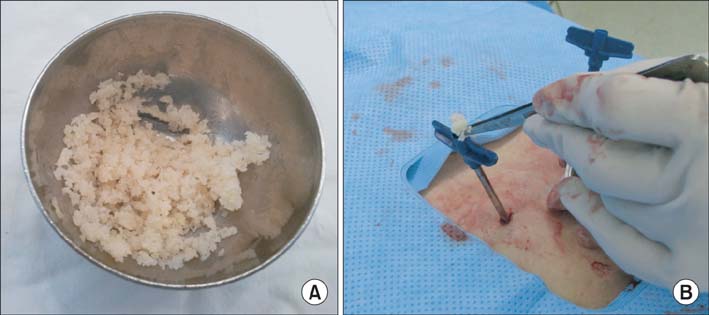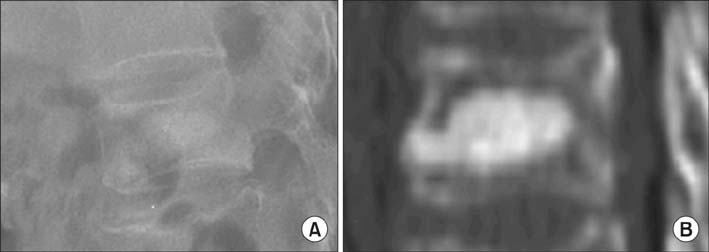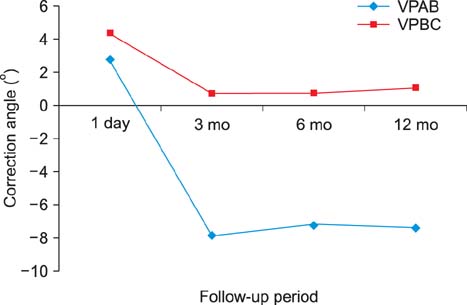Clin Orthop Surg.
2014 Mar;6(1):49-55. 10.4055/cios.2014.6.1.49.
Percutaneous Vertebroplasty Using Fresh Frozen Allogeneic Bone Chips as Filler
- Affiliations
-
- 1Department of Orthopedic Surgery, Seoul Sacred Heart General Hospital, Seoul, Korea. adkajs@hanmail.net
- KMID: 1737631
- DOI: http://doi.org/10.4055/cios.2014.6.1.49
Abstract
- BACKGROUND
Vertebroplasty is not free from cement related complications. If an allograft is used as a filler, most of them can be averted.
METHODS
Forty consecutive cases of osteoporotic vertebral fracture were divided into two groups by self-selection. The study and the control groups underwent vertebroplasty with fresh frozen allogeneic bone chips and bone cement, respectively. Clinical results were assessed at preoperation, postoperative day 1 and months 3, 6, and 12 by 10-grade visual analog scale (VAS), and radiological results were assessed at the same time by vertebral kyphotic angle (VKA) and local kyphotic angle (LKA). The results were compared within and between the groups. Survival function was analyzed. The criteria of an event were clinical or radiological deterioration versus pre-index surgery state.
RESULTS
VAS was improved in the study group from 8.4 +/- 0.8 to 5.2 +/- 1.4, 6.4 +/- 1.2, 5.5 +/- 2.7, and 3.7 +/- 1.4 at postoperative day 1 and months 3, 6, and 12, respectively, and in the control group from 8.4 +/- 1.2 to 3.2 +/- 1.1, 3.2 +/- 1.7, 3.2 +/- 2.7, and 2.5 +/- 1.7, respectively (within group, p < 0.001; between groups, p < 0.001). VKA was improved in the study group from 18.9degrees +/- 8.0degrees to 15.2degrees +/- 6.1degrees (p = 0.046) and in the control group from 14.7degrees +/- 5.2degrees to 10.3degrees +/- 4.7degrees (p < 0.001) at postoperative day 1. LKA was not improved in the study group but was improved in the control group from 16.8degrees +/- 11.7degrees to 14.3degrees +/- 9.6degrees (p = 0.015). Correction angle was 2.7degrees +/- 4.6degrees, -7.9degrees +/- 5.3degrees, -7.2degrees +/- 5.2degrees, and -7.4degrees +/- 6.3degrees at postoperative day 1 and months 3, 6, and 12, respectively, in the study group and 4.3degrees +/- 3.7degrees, 0.7degrees +/- 3.6degrees, 0.7degrees +/- 4.2degrees, and 0.1degrees +/- 4.4degrees, respectively, in the control group. Correction loss was significant in both groups (p < 0.001) and more serious in the study group (p < 0.001). The 6-month survival rate was 16.7% in the study group and 64.3% in the control group (p = 0.003; odds ratio, 5.250).
CONCLUSIONS
In treatment of osteoporotic vertebral fracture, fresh frozen allogeneic bone chips are not recommendable as a filler for its worse results than bone cement.
MeSH Terms
-
Aged
Bone Cements/adverse effects
Bone Substitutes/adverse effects
Case-Control Studies
Female
Humans
Male
Osteoporotic Fractures/epidemiology/*surgery
Pain Measurement
Transplantation, Homologous/adverse effects/instrumentation/*methods
Vertebroplasty/adverse effects/instrumentation/*methods
Bone Cements
Bone Substitutes
Figure
Reference
-
1. Pradhan BB, Bae HW, Kropf MA, Patel VV, Delamarter RB. Kyphoplasty reduction of osteoporotic vertebral compression fractures: correction of local kyphosis versus overall sagittal alignment. Spine (Phila Pa 1976). 2006; 31(4):435–441.2. Frankel BM, Monroe T, Wang C. Percutaneous vertebral augmentation: an elevation in adjacent-level fracture risk in kyphoplasty as compared with vertebroplasty. Spine J. 2007; 7(5):575–582.3. Chen HL, Wong CS, Ho ST, Chang FL, Hsu CH, Wu CT. A lethal pulmonary embolism during percutaneous vertebroplasty. Anesth Analg. 2002; 95(4):1060–1062.4. Blattert TR, Jestaedt L, Weckbach A. Suitability of a calcium phosphate cement in osteoporotic vertebral body fracture augmentation: a controlled, randomized, clinical trial of balloon kyphoplasty comparing calcium phosphate versus polymethylmethacrylate. Spine (Phila Pa 1976). 2009; 34(2):108–114.5. Peters KR, Guiot BH, Martin PA, Fessler RG. Vertebroplasty for osteoporotic compression fractures: current practice and evolving techniques. Neurosurgery. 2002; 51:5 Suppl. S96–S103.6. Phillips FM, Pfeifer BA, Lieberman IH, Kerr EJ 3rd, Choi IS, Pazianos AG. Minimally invasive treatments of osteoporotic vertebral compression fractures: vertebroplasty and kyphoplasty. Instr Course Lect. 2003; 52:559–567.7. Buchbinder R, Osborne RH, Ebeling PR, et al. A randomized trial of vertebroplasty for painful osteoporotic vertebral fractures. N Engl J Med. 2009; 361(6):557–568.8. Kallmes DF, Comstock BA, Heagerty PJ, et al. A randomized trial of vertebroplasty for osteoporotic spinal fractures. N Engl J Med. 2009; 361(6):569–579.9. Groen RJ, du Toit DF, Phillips FM, et al. Anatomical and pathological considerations in percutaneous vertebroplasty and kyphoplasty: a reappraisal of the vertebral venous system. Spine (Phila Pa 1976). 2004; 29(13):1465–1471.10. Bernhard J, Heini PF, Villiger PM. Asymptomatic diffuse pulmonary embolism caused by acrylic cement: an unusual complication of percutaneous vertebroplasty. Ann Rheum Dis. 2003; 62(1):85–86.11. Jang JS, Lee SH, Jung SK. Pulmonary embolism of polymethylmethacrylate after percutaneous vertebroplasty: a report of three cases. Spine (Phila Pa 1976). 2002; 27(19):E416–E418.12. Scroop R, Eskridge J, Britz GW. Paradoxical cerebral arterial embolization of cement during intraoperative vertebroplasty: case report. AJNR Am J Neuroradiol. 2002; 23(5):868–870.13. Lee BJ, Lee SR, Yoo TY. Paraplegia as a complication of percutaneous vertebroplasty with polymethylmethacrylate: a case report. Spine (Phila Pa 1976). 2002; 27(19):E419–E422.14. Shapiro S, Abel T, Purvines S. Surgical removal of epidural and intradural polymethylmethacrylate extravasation complicating percutaneous vertebroplasty for an osteoporotic lumbar compression fracture: case report. J Neurosurg. 2003; 98:1 Suppl. 90–92.15. Aebli N, Krebs J, Davis G, Walton M, Williams MJ, Theis JC. Fat embolism and acute hypotension during vertebroplasty: an experimental study in sheep. Spine (Phila Pa 1976). 2002; 27(5):460–466.16. Watts NB, Harris ST, Genant HK. Treatment of painful osteoporotic vertebral fractures with percutaneous vertebroplasty or kyphoplasty. Osteoporos Int. 2001; 12(6):429–437.17. Verlaan JJ, Oner FC, Verbout AJ, Dhert WJ. Temperature elevation after vertebroplasty with polymethyl-methacrylate in the goat spine. J Biomed Mater Res B Appl Biomater. 2003; 67(1):581–585.18. Truumees E, Hilibrand A, Vaccaro AR. Percutaneous vertebral augmentation. Spine J. 2004; 4(2):218–229.19. Amar AP, Larsen DW, Esnaashari N, Albuquerque FC, Lavine SD, Teitelbaum GP. Percutaneous transpedicular polymethylmethacrylate vertebroplasty for the treatment of spinal compression fractures. Neurosurgery. 2001; 49(5):1105–1114.20. Walker DH, Mummaneni P, Rodts GE Jr. Infected vertebroplasty: report of two cases and review of the literature. Neurosurg Focus. 2004; 17(6):E6.21. Barr JD, Barr MS, Lemley TJ, McCann RM. Percutaneous vertebroplasty for pain relief and spinal stabilization. Spine (Phila Pa 1976). 2000; 25(8):923–928.22. Fribourg D, Tang C, Sra P, Delamarter R, Bae H. Incidence of subsequent vertebral fracture after kyphoplasty. Spine (Phila Pa 1976). 2004; 29(20):2270–2276.23. Pflugmacher R, Schroeder RJ, Klostermann CK. Incidence of adjacent vertebral fractures in patients treated with balloon kyphoplasty: two years' prospective follow-up. Acta Radiol. 2006; 47(8):830–840.24. Mitarai N, Nori F. Wet granular materials. Adv Phys. 2006; 55(1-2):1–45.25. Patil N, Hwang K, Goodman SB. Cancellous impaction bone grafting of acetabular defects in complex primary and revision total hip arthroplasty. Orthopedics. 2012; 35(3):e306–e312.26. Tomita S, Molloy S, Jasper LE, Abe M, Belkoff SM. Biomechanical comparison of kyphoplasty with different bone cements. Spine (Phila Pa 1976). 2004; 29(11):1203–1207.27. Wilke HJ, Mehnert U, Claes LE, Bierschneider MM, Jaksche H, Boszczyk BM. Biomechanical evaluation of vertebroplasty and kyphoplasty with polymethyl methacrylate or calcium phosphate cement under cyclic loading. Spine (Phila Pa 1976). 2006; 31(25):2934–2941.28. Goldberg VM. The biology of bone grafts. Orthopedics. 2003; 26(9):923–924.29. Tsai CH, Lin RM, Ju CP, Chern Lin JH. Bioresorption behavior of tetracalcium phosphate-derived calcium phosphate cement implanted in femur of rabbits. Biomaterials. 2008; 29(8):984–993.30. Choi DJ, Ahn DK, Lee S, Park KY, Jun YW, Kim KS. Operative treatment of delayed collapse of osteoporotic vertebral fracture with claudication: transpedicular bone graft and pedicle screw fixation. J Korean Soc Spine Surg. 2007; 14(2):73–78.
- Full Text Links
- Actions
-
Cited
- CITED
-
- Close
- Share
- Similar articles
-
- Lumbar Root Injury by the Leakage of Bone Cement after the Percutaneous Vertebroplasty: A case report
- Percutaneous Vertebroplasty: Considerations for the Safe Procedures
- Fatal Hemothorax Following Percutaneous Vertebroplasty: A Case Report
- Two Cases of Percutaneous Vertebroplasty for Spinal Metastatic Cancer: A case report
- Intracardiac Foreign Body (Bone Cement) after Percutaneous Vertebroplasty





